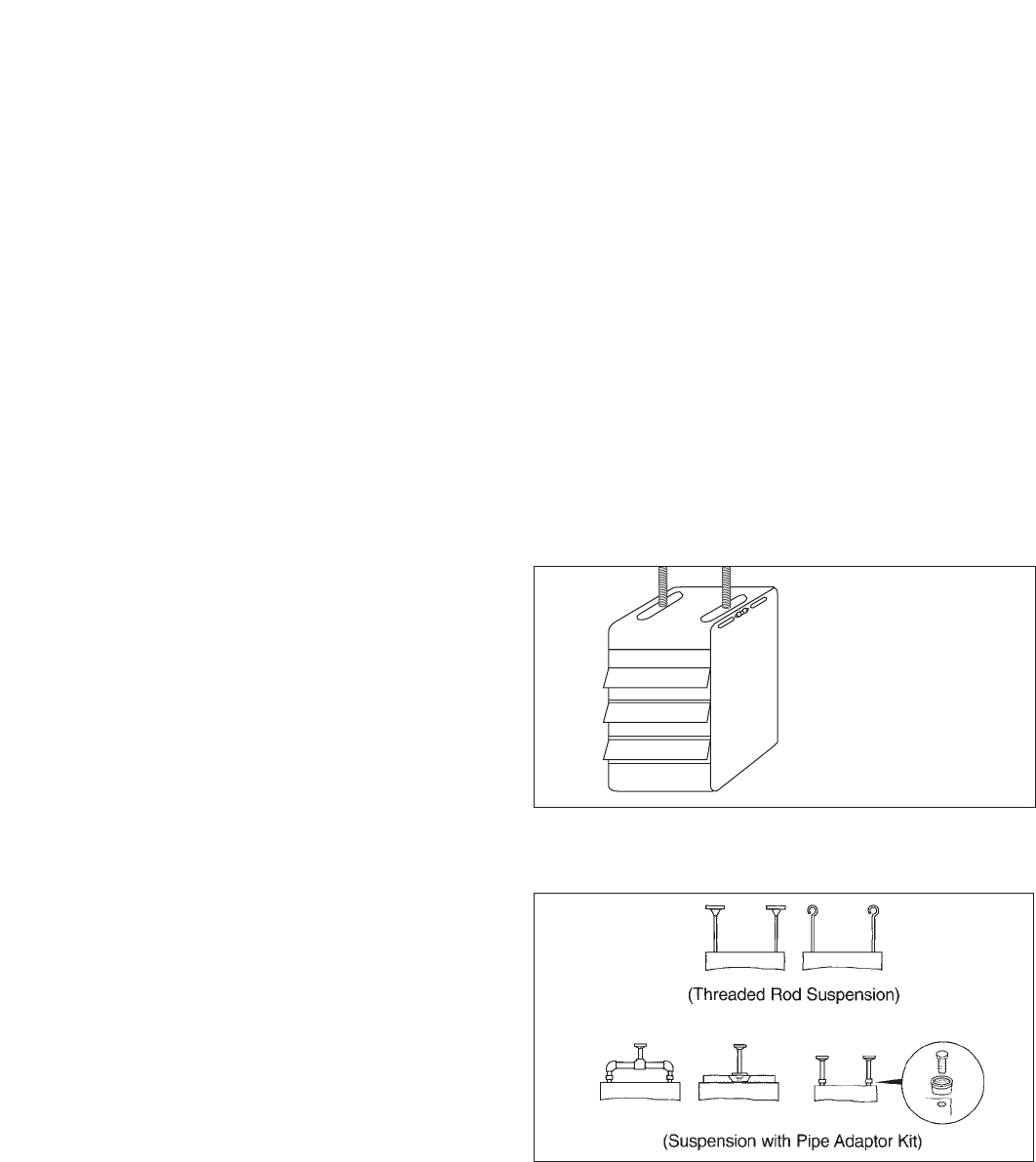
4
UNIT LOCATION
Sound and Vibration Levels
All standard mechanical equipment generates some sound and
vibration that may require attenuation. Libraries, private offices
and hospital facilities will require more attenuation, and in such
cases, an acoustical consultant may be retained to assist in the
application. Locating the equipment away from the critical area
is desirable within ducting limitations. Generally, a unit should
be located within 15 feet of a primary support beam. Smaller
deflections typically result in reduced vibration and noise
transmission.
UNIT LIFTING
All standard units are shipped fully boxed. Larger units are
also supplied with skid supports on the bottom of the box. The
larger units may be lifted from the bottom by means of a fork
lift or other lifting device only if the shipping support skids are
left in place and the forks support the whole depth of the unit.
If the unit must be lifted from the bottom for final installation
without the carton in place, be sure to properly support the unit
over its entire length and width to prevent damage. When lifting
units, make sure the load is balanced.
UNIT SUSPENSION
Be sure the method of unit suspension is adequate to support
the weight of the unit (see Weights for base unit and factory
installed option weights). For proper operation, the unit must
be installed in a level horizontal position. Combustible material
and service clearances as specified in Figure 3.1 and Tables
3.2 and 3.3 must be strictly maintained. To assure that flames
are directed into the center of the heat exchanger tubes, the
unit must be level in a horizontal position. Use a spirit level to
ensure that the unit is suspended correctly.
The most common method of suspending Modine gas unit
heaters is to utilize 3/8” threaded rod. On each piece of
threaded rod used, screw a nut a distance of about one inch
onto the end of the threaded rods that will be screwed into the
unit heater. Then place a washer over the end of the threaded
rod and screw the threaded rod into the unit heater weld nuts
on the top of the heater at least 5 turns, and no more than 10
turns. Tighten the nut first installed onto the threaded rod to
prevent the rod from turning. Drill holes into a steel channel or
angle iron at the same centerline dimensions as the heater that
is being installed. The steel channels or angle iron pieces need
to span and be fastened to appropriate structural members. Cut
the threaded rods to the preferred length, place them through
the holes in the steel channel or angle iron and secure with
washers and lock nuts or lock washers and nuts. A double nut
arrangement can be used here instead of at the unit heater (a
double nut can be used both places but is not necessary). Do
not install standard unit heaters above the maximum mounting
height shown in tables 17.1 or 17.3.
On all propeller units, except sizes 350 and 400, two tapped
holes (3/8-16) are located in the top of the unit to receive
threaded rods.
Units with two point suspension, sizes 30 through 300,
incorporate a level hanging feature. Depending on what options
and accessories are being used, the heater may not hang level
as received from the factory. Do not hang heaters with deflector
hoods until referring to the “installation manual for deflector
hoods” and making the recommended preliminary adjustments
on the heater. These preliminary adjustments need to be made
with the heater resting on the floor.
Propeller sizes 30 through 300 units without deflector hoods
that do not hang level after being installed, can be corrected
in place. Simply remove both outer side panels (screws to
remove are on back flange of side panel) and you will see the
(adjustable) mounting brackets (Fig. 4.1). Loosen the set screws
holding the mounting brackets in place and using a rubber
mallet or something similar, tap the heater into a position where
the unit hangs level. Re-tighten set screws and replace the
outer side panels.
Propeller sizes 350 and 400 have four mounting holes. On
all blower units, except the 350 and 400, two tapped holes
are provided in the top of the unit and two holes in the blower
support bracket. The 350 and 400 have four tapped holes in
the top of the unit and two in the blower support bracket for
mounting.
NOTE: A pipe hanger adapter kit, shown in Figure 4.2 is
available as an accessory. One kit consists of two drilled
3/4” IPS pipe caps and two 3/8 - 13 x 1-3/4” capscrews
to facilitate threaded pipe suspension.
Figure 4.1
Adjustable Mounting Brackets - To Adjust:
Figure 4.2
Suspension Methods
1. Remove outer side panels.
2. “Set screws” - loosen and
position bracket where needed
– then tighten set screws.
3. Re-attach outer side panels.
